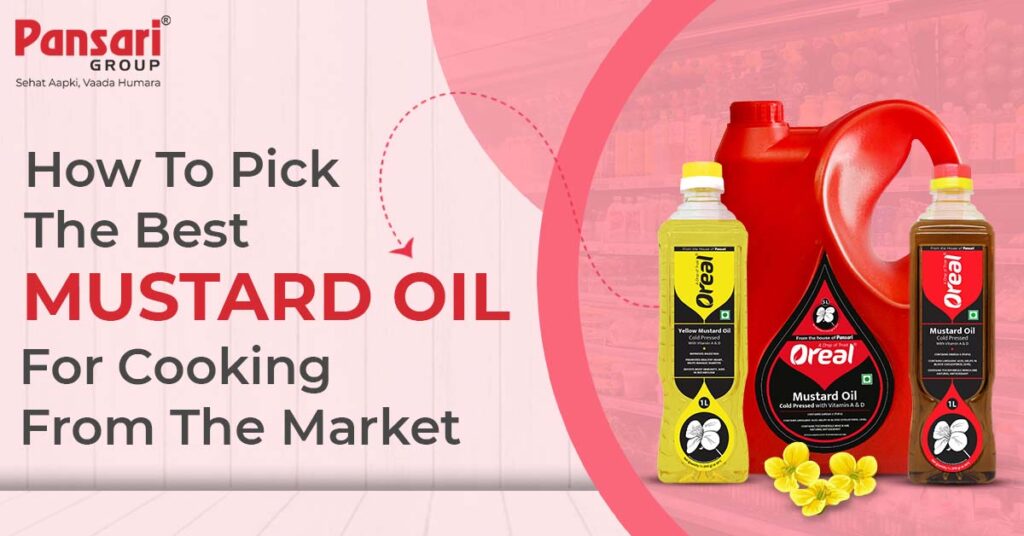There’s something special about mustard oil. As soon as it touches a hot pan, its strong smell spreads all around, reminding us of homemade food, tasty winter dishes, and tricks learned in grandma’s kitchen. In many Indian homes, this golden oil is always a part of cooking.
But with so many options available today, knowing how to choose the best mustard oil can be confusing.
Pansari Group brings you this complete guide to help you pick the best mustard oil for cooking. Each point shared here will help you avoid fake promises and select an oil that’s good for both taste and health.
So grab a cup of chai and read this till the end, your kitchen deserves nothing less.
Why Mustard Oil Is a Staple in Indian Cooking
Before diving into the buying guide, let’s understand why mustard oil is such a cherished choice in Indian kitchens.
- Strong aroma and flavor: It adds a pungent kick that’s essential for Bengali, Punjabi, Rajasthani, and Bihari dishes.
- Natural preservative: Its antimicrobial properties keep pickles fresh for months.
- Health benefits: Loaded with monounsaturated and polyunsaturated fats, omega-3, vitamin E, and antioxidants.
- Promotes digestion and skin health: Many believe it aids metabolism and skin texture.
With so many benefits packed in one oil, selecting the right one becomes crucial.
Why Choosing the Best Mustard Oil Matters
You might wonder, “Isn’t all mustard oil the same?” Not at all.
The quality varies depending on the seed, extraction process, packaging, and storage conditions. The best mustard oil for cooking preserves the nutritional value, delivers the perfect flavor, and is safe for regular use.
Substandard oil can:
- Affect the taste of your dishes
- Cause digestion issues
- Contain harmful additives or chemical residues
- Lose its nutrients when overheated
That’s why choosing carefully is not a luxury, it’s a necessity. Established FMCG companies like Pansari Group understand this importance and bring oils that combine tradition, hygiene, and authenticity, making it easier to choose without second-guessing.
Types of Mustard Oil in the Market
Before buying, it’s important to know what types of mustard oils are commonly available:
- Kachchi Ghani (Cold-Pressed Mustard Oil)
This is extracted at low temperatures, keeping the nutrients, aroma, and original flavor intact. It is the most traditional and highly recommended choice. - Refined Mustard Oil
In this process, the oil is treated to remove odor and color. While it may be lighter, it often lacks the deep flavor and may have fewer nutrients. - Blended Oils
These are mixed with other vegetable oils. They might be cheaper, but purity is often compromised.
Always go for cold-pressed or Kachchi Ghani mustard oil if cooking and health are your priorities. This is exactly why trusted brands like Pansari Group focus on producing pure, cold-pressed mustard oils suitable for daily Indian cooking.
Check for These Signs Before Buying
Let’s get into the real deal now, how to choose best mustard oil while shopping. These tips will make sure you pick the right bottle every time.
1. Always Check the Label
The first thing is the back of the bottle. A good brand is transparent about its process.
- Look for the words “Kachchi Ghani” or “Cold Pressed”
- Ensure “100% pure mustard oil” is mentioned
- Check FSSAI certification and manufacturing license
- Avoid oils with artificial colors, added fragrances, or chemicals
A simple label tells a lot, never ignore it.
2. Inspect the Colour and Consistency
Mustard oil naturally has a dark yellow or deep amber color. It should be:
- Not too thick
- Not watery
- Slightly sharp to the nose
Hold the bottle against light. Cloudy or unusually clear oil can indicate impurities or excessive refining.
3. Smell is a Strong Indicator
The natural pungency is not just for taste, it signals freshness.
- Take a whiff (if the store allows)
- Strong, peppery, slightly bitter aroma is a good sign
- If it smells like nothing or like chemicals, move on
Real mustard oil never hides its identity.
4. Packaging Matters
Good packaging ensures no light or air spoils the oil.
- Prefer dark glass bottles or high-quality plastic bottles with proper sealing
- Avoid loose or unlabelled oil sold in local shops
- Vacuum-sealed bottles extend shelf life and retain purity
Even the best mustard oil for cooking loses quality in bad packaging. Pansari Group take extra care in this area by using hygienic and tamper-proof packaging that preserves freshness till the last drop.
5. Source of Mustard Seeds
Seeds matter as much as the process.
- Best oils come from high-quality Indian mustard seeds, mainly grown in Rajasthan, Punjab, and UP
- Some premium brands even highlight seed source on the label
Knowing the seed quality gives extra assurance.
6. Acid Value & Adulteration Test
Advanced buyers look for acidity levels on the label, lower the acid value, fresher the oil.
To test adulteration at home:
- Refrigeration Test: Keep the oil in the fridge. If it thickens uniformly, it’s pure.
- Palm Test: Rub a drop between palms. Pure oil gives a warm sensation.
Such tricks can save you from long-term health risks.
7. Check Expiry and Manufacturing Date
Always go for a recent batch. Older bottles may have lost flavor and nutrition.
- Best consumed within 6–9 months of packaging
- Avoid oils nearing expiry, even on discounts
Freshness makes a big difference in cooking taste.
8. Look for Certifications and Lab Tests
Reputed brands often showcase:
- AGMARK certification
- Lab-tested purity claims
- ISO certifications
These symbols show the brand values safety and quality. Pansari Group, being a well-established name in the FMCG sector, consistently meets these standards, assuring users of quality with every bottle.
9. Taste Test (Once Bought)
Once at home, heat a spoonful. It should:
- Release a spicy aroma
- Turn slightly frothy
- Taste bold and earthy
If it fails this test, don’t use it regularly.
10. Choose According to Cuisine
Different regions prefer different textures and strength.
- Bengali and Bihari dishes need strong pungency
- Light North Indian gravies may prefer milder tone
- Pickle makers often need raw, thick oil with sharp notes
Matching oil strength with cuisine style enhances taste.
11. Avoid Overly Cheap Options
If it feels too good to be true, it probably is.
- Extremely cheap oils often contain additives
- May be mixed with rice bran or palm oil
Spending a few extra rupees ensures both safety and satisfaction.
Wrapping It Up
Finding the best mustard oil for cooking is not about fancy labels or celebrity ads. It’s about purity, tradition, and health. This guide has covered every trick and detail needed to identify, buy, test, and use mustard oil like a pro. No kitchen in India should have to compromise on this golden treasure.
Still wondering how to choose best mustard oil?
Keep this blog saved. Every time you’re at the store or browsing online, revisit these points.
If you’re looking to make a confident, no-compromise choice, Pansari Oils offer the perfect blend of purity, strength, and heritage. Trusted by millions across India, Pansari’s mustard oil is cold-pressed using high-quality seeds and packed under hygienic conditions. It’s crafted for everyday Indian cooking, full of flavor, nutrients, and tradition.
FAQ’s
1. What is the best mustard oil for cooking in India?
The best mustard oil for cooking in India is cold-pressed (Kachchi Ghani), 100% pure, and made using high-quality Indian mustard seeds. Brands like Pansari Group offer trusted options.
2. How to identify pure mustard oil at home?
You can test purity by refrigerating the oil; pure mustard oil thickens evenly. Also, rub it between your palms, it should feel warm and have a strong, pungent smell.
3. Is mustard oil safe for daily cooking?
Yes, pure mustard oil is safe for daily cooking when used in moderation. It contains good fats and antioxidants that support heart and skin health.

